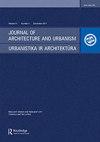基于绿色理念的日惹kampong pakunen的规划与设计
IF 0.8
0 ARCHITECTURE
引用次数: 5
摘要
本研究旨在通过基于日常活动、建筑材料和燃料消耗的绿色概念和碳足迹方法确定贫民窟“kampong”的绿色概念,并传达可再生能源的概念。碳足迹是对日常主要活动和日常使用的产品积累直接或间接造成的二氧化碳气体排放总量的度量。这是日惹甘平县的案例研究。这个甘榜是一个人口稠密的甘榜,位于市中心,距离日惹市商业和商业区的中心Malioboro不远。采用的方法是现有条件和规划条件碳足迹的定量比较法和可再生能源的定量法。结果表明,在现有条件下,磅堡村的二氧化碳浓度为1712.767吨CO2/月,而设计的二氧化碳浓度总量为1293.785吨CO2/月,减少了24.462%的二氧化碳浓度。为了节约日常生活中的能源消耗,建议使用水轮作为微型水力发电。本文章由计算机程序翻译,如有差异,请以英文原文为准。
THE PLANNING AND DESIGN OF KAMPONG PAKUNCEN IN YOGYAKARTA BASED ON THE GREEN CONCEPT
This study aims to determine the green concept of a slum “kampong” with the green concept and carbon footprint approach based on daily activities, building materials and fuel consumption as well as to deliver the concept of renewable energy. The carbon footprint is the measure of total amount of carbon dioxide gas emissions directly or indirectly caused by daily main activities and accumulation of products used daily. It is the case study of Kampong Gampingan-Pakuncen, Yogyakarta. This kampong is known as a densely populated kampong located in the city centre not far from Malioboro, the centre of commercial and business districts in Yogyakarta City. The employed methods were the quantitative-comparative method between carbon footprint of existing and planning condition and the quantitative approach of renewable energy. The results showed that the carbon dioxide concentration of Kampong Pakuncen in the existing condition is 1,712.767 tonnes CO2/month while the total amount of carbon dioxide concentration of the design is 1,293.785 tonnes CO2/month, hence 24.462% carbon dioxide concentration reduction. To save energy consumption in daily activities, it is proposed that water wheel as micro-hydro power should be used for electricity.
求助全文
通过发布文献求助,成功后即可免费获取论文全文。
去求助
来源期刊

Journal of Architecture and Urbanism
ARCHITECTURE-
CiteScore
1.30
自引率
14.30%
发文量
12
审稿时长
15 weeks
期刊介绍:
The Journal of Architecture and Urbanism publishes original research on all aspects of urban architecture.
 求助内容:
求助内容: 应助结果提醒方式:
应助结果提醒方式:


